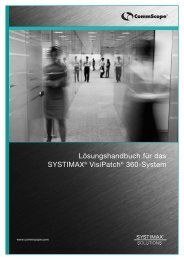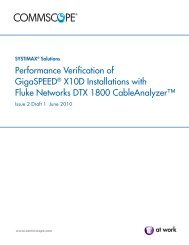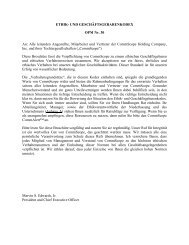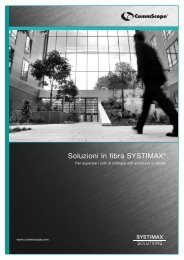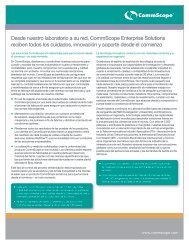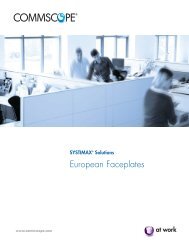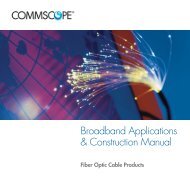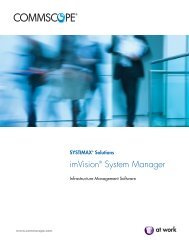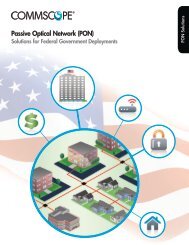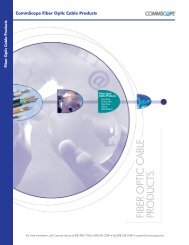CommScope® Enterprise Data Center Design Guide - Public ...
CommScope® Enterprise Data Center Design Guide - Public ...
CommScope® Enterprise Data Center Design Guide - Public ...
Create successful ePaper yourself
Turn your PDF publications into a flip-book with our unique Google optimized e-Paper software.
32<br />
www.commscope.com<br />
TABLE 4: TIA SUPPORTABLE DISTANCES<br />
Application Parameter<br />
Nominal wavelength (nm)<br />
Ethernet<br />
10/100BASE-SX<br />
Ethernet<br />
100BASE-FX<br />
Ethernet<br />
1000BASE-SX<br />
Ethernet<br />
1000BASE-LX<br />
Ethernet<br />
10GBASE-S<br />
Ethernet<br />
10GBASE-LX4<br />
Ethernet<br />
10GBASE-L<br />
Ethernet<br />
10GBASE-LRM<br />
Fibre Channel<br />
100-MX-SN-I<br />
(1062 Mbaud)<br />
62.5/125 µm<br />
TIA 492AAAA<br />
(OM1)<br />
Multi-mode Single-mode<br />
50/125 µm 850 nm TIA 492CAAA<br />
laser- optimized (OS1)<br />
50/125 µm<br />
TIA 492AAAB TIA 492AAAC TIA 492CAAB<br />
(OM2) (OM3) (OS2)<br />
850 1300 850 1300 850 1300 1310 1550<br />
Channel attenuation (dB) 4.0 - 4.0 - 4.0 - - -<br />
Supportable<br />
distance m (ft)<br />
300<br />
(984)<br />
- 300<br />
(984)<br />
- 300<br />
(984)<br />
- - -<br />
Channel attenuation (dB) - 11.0 - 6.0 - 6.0 - -<br />
Supportable<br />
distance m (ft)<br />
- 2000<br />
(6560)<br />
- 2000<br />
(984)<br />
- 2000<br />
(984)<br />
- -<br />
Channel attenuation (dB) 2.6 - 3.6 - 4.5 - - -<br />
Supportable<br />
distance m (ft)<br />
275<br />
(900)<br />
- 550<br />
(1804)<br />
- 800<br />
(2625)<br />
- - -<br />
Channel attenuation (dB) - 2.3 - 2.3 - 2.3 4.5 -<br />
Supportable<br />
distance m (ft)<br />
550<br />
(1804)<br />
- 550<br />
(1804)<br />
- 550<br />
(1804)<br />
5000 -<br />
(16405)<br />
Channel attenuation (dB) 2.4 - 2.3 - 2.6 - - -<br />
Supportable<br />
distance m (ft)<br />
33<br />
(108)<br />
- 82<br />
(269)<br />
- 300<br />
(984)<br />
- - -<br />
Channel attenuation (dB) - 2.5 - 2.0 - 2.0 6.3 -<br />
Supportable<br />
distance m (ft)<br />
- 300<br />
(984)<br />
- 300<br />
(984)<br />
- 300<br />
(984)<br />
10000 -<br />
(32810)<br />
Channel attenuation (dB) - - - - - - 6.2 -<br />
Supportable<br />
distance m (ft)<br />
- - - - - - 10000<br />
(32810)<br />
-<br />
Channel attenuation (dB) - 1.9 - 1.9 - 1.9 - -<br />
Supportable<br />
distance m (ft)<br />
- 220<br />
(720)<br />
- 300<br />
(984)<br />
- 300<br />
(984)<br />
- -<br />
Channel attenuation (dB) 3.0 - 3.9 - 4.6 - - -<br />
Supportable<br />
distance m (ft)<br />
300<br />
(984)<br />
- 500<br />
(1640)<br />
- 860<br />
(2822)<br />
- - -<br />
Optical distances<br />
Optical components that meet TIA standards should be able to meet the distances given within<br />
Table 4. There are a few key points to highlight though. There are 3 types of multimode fiber<br />
described 62.5 μm (OM1), 50 μm and laser-optimized 50 μm (OM3). So one cannot simply<br />
ask what is the distance for “multimode” fiber when evaluating a solutions capability. In most<br />
data center applications today, OM3 fiber will be required for its capability to provide 10<br />
G/s speeds over a 300 meter distance. Additionally, an “enhanced” OM4 fiber, not shown in<br />
this table, is commonly available today and will provide longer 10G distances, out to 550<br />
meters.<br />
The standards offer a convenient look at the capability of the media, but this “one-number”<br />
has great limitations. On the copper side, the table does not provide an estimate of the<br />
available bandwidth performance headroom. If a high-bandwidth Category 6 cable is utilized,<br />
there may be headroom to spare, but Category 5e cabling may be barely sufficient.<br />
On the fiber side, the distances are provided with the assumption that the distance is point to<br />
point. This means that there are no interconnects, cross-connects or splices within the link. Most<br />
systems are more complicated than this, however, and the extra loss associated with a crossconnect<br />
must be accounted for as a potentially shortened distance.



